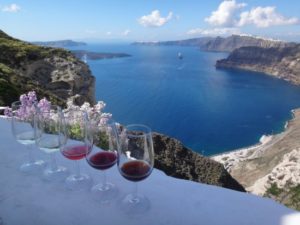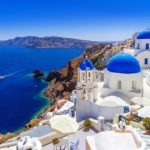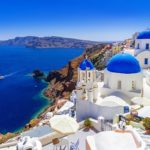8 hours
Private Tour
English
UP TO 14 GUESTS
Santorini All Inclusive Full Day Private Tour
Got a Question?
Contact UsHighlights

Santorini Full Day private tour
- Firostefani
- Blue Domed Church
- Profitis Ilias Church
- Oia
- Monolithos Beach (Black Beach)
- Winery- Wine Tasting
- Lunch
- Akrotiri Excavation
- Red Beach
Itinerary
This tour is the perfect way to discover the treasures of Santorini!
 The tour starts with a drive to Firostefani.
The tour starts with a drive to Firostefani.
The old cobblestone path is the best way to visit this picturesque settlement, enjoying the magnificent view to the Caldera.
The blue dome of Aghioi Theodoroi church (Saints Theodore) is featured in many photos of Santorini. Should you find it open, take a look at the old icon on its chancel screen. Two smaller Catholic chapels, dedicated to Panagia (Virgin Mary) and Aghioi (St) Theodoroi used to stand at this very point, in the past. In 1570, a sailor brought back from Russia an icon depicting Virgin Mary holding baby Jesus. In order to honour it, the Catholics built a big church in the place of the two smaller chapels, and soon people spread the word that the icon was miraculous.
As you are walking in Firostefani with your local tour leader, you will also come across the church of Aghios Gerassimos and the square, a meeting point for locals and tourists.
The settlement has luxurious hotels, rooms to let, restaurants, cafes, mini markets and other shops.
 The Blue Domed Church of Santorini island is the most iconic church, that matches perfectly the blue sky with the backround of the Aegean Sea in Santorini’s caldera.
The Blue Domed Church of Santorini island is the most iconic church, that matches perfectly the blue sky with the backround of the Aegean Sea in Santorini’s caldera.
This church is depicted in every cardpostal, advertizing the idyllic vacation in the Greek islands.
On your way to Oia, you will make some great photo stops with breath- taking views!
 The church of the Prophet Ilias is located on the venetian path route between Oia and Fira, at an altitude of 304meters above the sea level.
The church of the Prophet Ilias is located on the venetian path route between Oia and Fira, at an altitude of 304meters above the sea level.
Built in 1750, the white building with the blue dome and the triple bell tower, offers the visitor amazing views to both east and west sides of the island, because of its location next to the slimmest part of the island!

Next, you will be to Oia (pronounced Ia), which is the most famous of all villages of Santorini. It is known throughout the world for its beauty, the incredible sunset and some amazing hotels. It is certainly the most beautiful and picturesque village of Santorini (and some say of Greece). The village is situated on top of an impressive cliff and offers a spectacular view over the volcano and the island of Thirassia.
Oia is a traditional village with charming houses in narrow streets, blue-domed churches, and sun-bathed verandas. Its streets have plenty of tourist shops, restaurants, cafes, and other shops. Oia is quieter than Fira and the busiest area is the main pedestrian that runs along its length. At the entrance of the village there is a car park, where visitors can leave their vehicle and enjoy long walks in the picturesque paths. The volcano from here is much less imposing but you can still get some gorgeous views. Many artists fell in love with the area and settled there. For that reason, the village of Oia has many art galleries.
 After your walk in Oia, you will be driver to Monolithos beach.
After your walk in Oia, you will be driver to Monolithos beach.
It is an ideal place for a quiet relaxing holiday, with crystal clear waters and a fine black sand beach.
Located on the south east coastline of Santorini, the village took its name from the large rock ‘Monolitho’ upon which stands the church of Agios Ioannis.
 Next, you will visit one of the famous wineries of Santorini, where you will sense the unique taste of Vinsanto and the other Protected Destination of Origin wines, while enjoying the Sunset with breath-taking views of the caldera! (The winery will be chosen depending on the availability).
Next, you will visit one of the famous wineries of Santorini, where you will sense the unique taste of Vinsanto and the other Protected Destination of Origin wines, while enjoying the Sunset with breath-taking views of the caldera! (The winery will be chosen depending on the availability).

You will be feeling hungry by now, so your next stop will be at a traditional – family owned tavern, where you will enjoy Greek authentic local cuisine, just a few meters from the sea!
Later, you will reach Akrotiri, a Minoan Bronze Age settlement on the volcanic Greek island of Santorini. The settlement was destroyed in the Theran Eruption sometime in the 16th century BC and buried in volcanic ash, which preserved the remains of fine frescoes and many objects and artworks. The settlement has been suggested as a possible inspiration for Plato’s story of Atlantis. Akrotiri has been excavated since 1967.
 Akrotiri archaeological site is open to visitors, set in a big, light and airy building. The ruins need to be covered up as the houses are made of mud bricks so would get damaged by water.
Akrotiri archaeological site is open to visitors, set in a big, light and airy building. The ruins need to be covered up as the houses are made of mud bricks so would get damaged by water.
Walkways are suspended above the ruins and take you around the edge of the city. But what’s ground level for us is roof height in Akrotiri – the layer of ash was up to 40 metres thick in places so it takes a lot of painstakingly digging and the removal of huge quantities of rock to get down to the original street level. A pathway leads down through some of the reconstructed houses, where you can see details like an original Minoan toilet and a stone bathtub.
During the excavations lots of different remnants of people’s everyday lives were uncovered among the buildings, and they’re what makes the site so fascinating. The ash has perfectly preserved the Minoan way of life, from painted frescoes to hundreds of pots. These range from drinking cups up to giant storage vessels decorated with geometric patterns. Many are amazingly still intact, and some even had remains of olive oil or fish inside.
You can see some artifacts at the site, but many others have been moved to the archaeological museum in Fira, and the best of Akrotiri’s frescoes are on display in Athens’ National Archaeological Museum. Furniture like beds, chairs and tables have been recreated by pouring plaster into the casts made by the ash, like they did with people’s bodies in Pompeii. But the big difference at Akrotiri is that no human or animal remains were found here.
It’s thought there were probably lots of foreshocks before the big eruption, so the Minoans had time to pack up their livestock and valuables and leave the city, unlike in Pompeii where it all happened so quickly. As it was a rich seafaring city, people probably had easy access to boats which made it easy for them to escape. Though where they went next and why they never came back to Santorini is another of the many mysteries that surround Akrotiri.
Your last stop will be at The Red beach: One of the most scenic and interesting beaches on the island, located near Akrotiri village. The reason for its popularity is its colour!
 A huge attraction of the island and arguably the most famous beach lies on the southernmost part of Santorini. It is located in Akrotiri village, close to the important archaeological site of Akrotiri. To reach the beach you have to walk a couple of minutes on a downhill path. A great number of visitors come to Red Beach just to stare and photograph it.
A huge attraction of the island and arguably the most famous beach lies on the southernmost part of Santorini. It is located in Akrotiri village, close to the important archaeological site of Akrotiri. To reach the beach you have to walk a couple of minutes on a downhill path. A great number of visitors come to Red Beach just to stare and photograph it.
Red Beach is without a doubt worth a visit considering that it is a rare sight, probably unique in the whole world, where red is the dominant color. It is enclosed by steep red hills that create a captivating, wild scenery. If you stand on the top you will set eyes on enormous volcanic rocks situated in the sea, small pebbles and sand of various colors, mainly red, all along the beach and appealing dark blue waters. This wonderful palette of contrasting colors will mesmerize you. Another natural marvel the volcano created.
Don’t forget to take many photos of this incomparable landscape and the images of natural beauty it lavishly offers.
Inclusions - Exclusions
Private Tours are personal and flexible just for you and your party.
Inclusions:
-
Professional Drivers with Deep knowledge of history [Not licensed to accompany you in any site]
- Entrance Fees
- Lunch Wine Tasting
-
Hotel/ Port pickup and drop-off
-
Transport by private vehicle
- Bottled water
Exclusions:
- Licensed Tour guide or Local tour Leader upon request depending on availability [Additional cost]
- Personal Expenses
Entrance Fees
Holidays:
- 1 January: closed
- 25 March: closed
- 1 May: closed
- Easter Sunday: closed
- 25 December: closed
- 26 December: closed
History
According to searches and excavations on Santorini, the first human presence on the island dates back to the Neolithic Period. Santorini hosted an important civilization around 3600 BCE. Discoveries made in an important city near Akrotiri and the famous Red Beach show the existence of an ancient Minoan colony. The city was very similar to those found in the island of Crete, with many wall ornaments and pottery showing naturalistic landscapes of animals and humans of the same ancient Minoan style. In ancient times, Santorini Island was known as Stongili, which means round in Greek. Strongili was the victim of an enormous volcanic eruption in 1,500 BCE.
The eruption was so huge that many consider it to be the main cause of the destruction of the great Minoan civilization on the island of Crete, situated 70 nautical miles away. Specialists believe that the explosion was so great that it created gigantic waves that reached the shores of the surrounding islands and Crete. After the explosion, the centre of Santorini sank, and the many earthquakes that followed destroyed a big part of the rest of the island. Many studies and research have been presented about the volcano of Santorini, including a series of documentaries by National Geographic. In some ancient myths, the destruction of the island is closely associated to the legend of Atlantis. According to history, Phoenicians settled on ancient Thera around 1,300 BCE and stayed for five generations.
Then, around 1100 BCE, the island was occupied by the Lacedaemonians. Around 825 BCE, the inhabitants of the island, then named Thera, were using the Phoenician alphabet. In the 7th and 6th centuries BCE, Thera had commercial and trade relations with most of the islands and cities of Greece. During the Hellenistic Period, Thera, because of its central position in the Aegean, became an important trade centre and an important naval base, due to its strategically perfect position. Between 1200 AD and 1579 AD, the island was under Byzantine rule and the church of Episkopi Gonia was founded. In 1204 AD the island is surrendered to the Venetian Marco Sanudo and becomes part of the Duke of the Aegean. The name of the island was given by the Venetians after the Santa Irini, the name of a catholic church. During that time there is a strong battle between Venetians and pirates. During the Turkish rule (1579-1821) the island succeeds in trading development with the ports of Eastern Mediterranean. The period that follows is quite prosperous.
Due to the wars of the 20th century, Santorini’s economy declines and the inhabitants abandon the island after the catastrophic earthquake in 1956. The tourist development in Santorini begins in the 1970s and today it is one of the best tourist destinations in the world. Over the years, Santorini has also developed as a wedding and honeymoon destination, while many international meetings and conferences take place there in summer, at the Nomikos Conference Center or in luxurious hotels.
Cancellation Policy

All cancellations must be confirmed by Olive Sea Travel.
Regarding the Day Tours:
Cancellations up to 24 hours before your service date are 100% refundable.
Cancellation Policy:
- Licensed Tour Guides and Hotels are external co-operators & they have their own cancellation policy.
- Apart from the above cancellation limits, NO refunds will be made. If though, you fail to make your appointment for reasons that are out of your hands, that would be, in connection with the operation of your airline or cruise ship or strikes, extreme weather conditions or mechanical failure, you will be refunded 100% of the paid amount.
- If your cancellation date is over TWO (2) months away from your reservation date, It has been known for third-party providers such as credit card companies, PayPal, etc. to charge a levy fee usually somewhere between 2-4%.
- Olive Sea Travel reserves the right to cancel your booking at any time, when reasons beyond our control arise, such as strikes, prevailing weather conditions, mechanical failures, etc. occur. In this unfortunate case, you shall be immediately notified via the email address you used when making your reservation and your payment WILL be refunded 100%.














